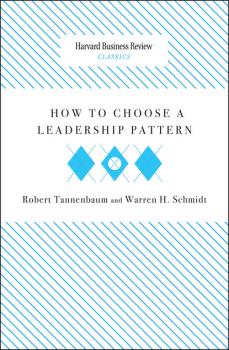Управление, подбор персонала
Различные книги в жанре Управление, подбор персоналаHow to Choose a Leadership Pattern
You're the boss: Should you call all the shots? Pick a course of action, then «sell» your idea to employees? Gather input from subordinates but make final decisions yourself? Let your group solve problems? Each approach has its advantages and disadvantages. How to Choose a Leadership Pattern offers strategies for selecting the best approach-depending on considerations such as your values, your subordinates' abilities, and the situation (including the degree of time pressure you're under). Since 1922, Harvard Business Review has been a leading source of breakthrough ideas in management practice. The Harvard Business Review Classics series now offers you the opportunity to make these seminal pieces a part of your permanent management library. Each highly readable volume contains a groundbreaking idea that continues to shape best practices and inspire countless managers around the world.
How I Learned to Let My Workers Lead
Are your employees like a synchronized "V" of geese in flight-sharing goals and taking turns leading? Or are they more like a herd of buffalo-blindly following you and standing around awaiting instructions? If they're like buffalo, their passivity and lack of initiative could doom your company. In How I Learned to Let My Workers Lead , you'll discover how to transform buffalo into geese-by reshaping organizational systems and redefining employees' expectations about what it takes to succeed. Since 1922, Harvard Business Review has been a leading source of breakthrough ideas in management practice. The Harvard Business Review Classics series now offers you the opportunity to make these seminal pieces a part of your permanent management library. Each highly readable volume contains a groundbreaking idea that continues to shape best practices and inspire countless managers around the world.
One More Time
Imagine overseeing a workforce so motivated that employees relish more hours of work, shoulder more responsibility themselves; and favor challenging jobs over paychecks or bonuses. In One More Time: How Do You Motivate Employees? Frederick Herzberg shows managers how to shift from relying on extrinsic incentives to activating the real drivers of high performance: interesting, challenging work and the opportunity to continually achieve and grow into greater responsibility. The results? An ultramotivated workforce. Since 1922, Harvard Business Review has been a leading source of breakthrough management ideas-many of which still speak to and influence us today. The Harvard Business Review Classics series now offers readers the opportunity to make these seminal pieces a part of your permanent management library. Each highly readable volume contains a groundbreaking idea that continues to shape best practices and inspire countless managers around the world-and will have a direct impact on you today and for years to come.
Seven Steps to Leading a Gender-Balanced Business
The proven rewards of a gender-balanced business.Scores of studies have shown the benefits to the bottom line of gender-balanced organizations. A handful of smart companies have tapped into the opportunities of today’s female consumer base and talent pool—yet too many companies still struggle with an outdated and ineffective imbalance of genders, across all levels, functions, and geographies.Now, Avivah Wittenberg-Cox brings a practical, seasoned voice to the problem of gender imbalance in business, laying out proven actions designed to make gender balance a sustainable reality. Wittenberg-Cox, CEO of the consultancy 20-first, has worked with some of the world’s largest and most reputable firms to deliver the benefits of balance. In this HBR Single ebook, she outlines what companies need to do to bring about real change. Beyond the usual well-intentioned but often ineffective mentoring and networking programs for women, the author argues that building gender balance is a twenty-first century management and leadership skill. Bringing a business into successful gender balance requires leaders who have a strategic understanding of the considerable economic benefits that lie untapped in the female population—in their roles both as customers and as talent—and the competencies needed to work across genders.It’s time for businesses to tap into 100% of the talent pool and connect with 100% of the market—both male and female. Wittenberg-Cox tells us how and why gender balance needs to happen now—and how to achieve it.HBR Singles provide brief yet potent business ideas, in digital form, for today’s thinking professional.









